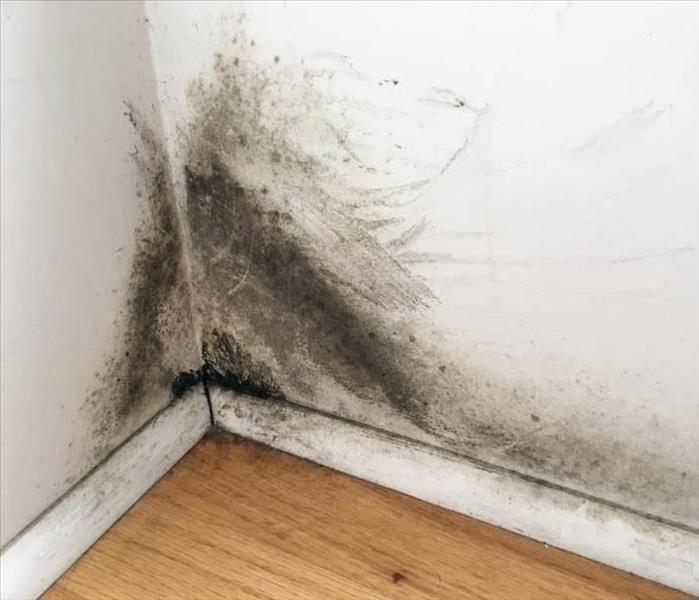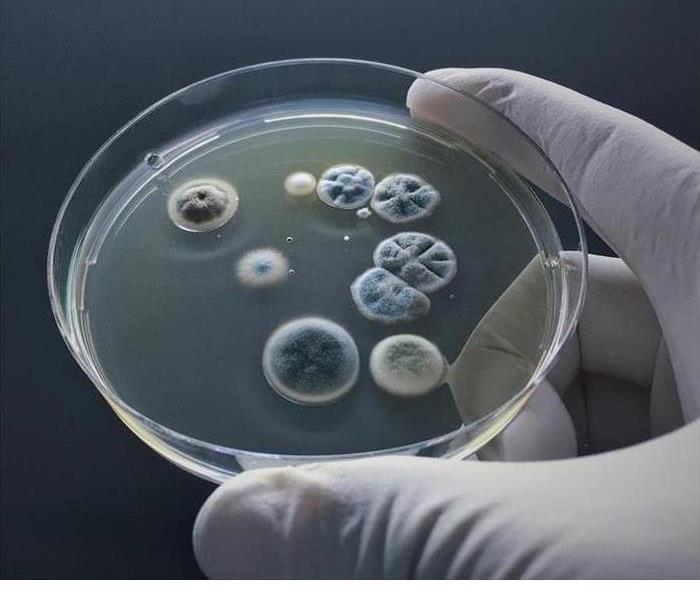Does Your Coraopolis Home Have A Mold Problem?
3/25/2024 (Permalink)
Microscopic mold spores naturally occur almost everywhere, both outdoors and indoors. This makes it impossible to remove all mold from a home or business. Therefore, mold remediation reduces the mold spore count back to its natural or baseline level. Some restoration businesses advertise “mold removal” and even guarantee to remove all mold, which is a fallacy. Consider the following mold facts:
- Mold is present almost everywhere, indoors and outdoors.
- Mold spores are microscopic and float along in the air and may enter your home through windows, doors, or AC/heating systems or even hitch a ride indoors on your clothing or a pet.
- Mold spores thrive on moisture. Mold spores can quickly grow into colonies when exposed to water. These colonies may produce health effects.
- Before mold remediation can begin, any sources of water or moisture must be addressed. Otherwise, the mold may return.
- Mold often produces a strong, musty odor and can lead you to possible mold problem areas.
- Even higher-than-normal indoor humidity can support mold growth. Keep indoor humidity below 45 percent.
If your home or business has a mold problem, we can inspect and assess your property and use our specialized training, equipment, and expertise to remediate your mold infestation.
If You See Signs of Mold, Call Us Today – (412) 299-5520
How to Prevent Mold Growth After a Flood
4/22/2021 (Permalink)
If you have had a storm and your business or home was damaged, you should act quickly to keep your building from being affected further. Mold growth can occur quickly, sometimes overnight, when water is not removed. To prevent this fungus from spreading, take the following steps.
- Start Mitigation Quickly
One of the first things that you should do is to contact a professional service to begin work on mitigation. This stage takes place before restoration and is done to keep damage from spreading or getting worse. Standing water will be removed, and the area will be cleaned.
- Dry Everything Thoroughly
Because mold growth happens in areas with excessive moisture, just removing the water is not enough to keep it from spreading. Opening windows and doors can help the air circulate and speed up the process. A dehumidifier can also be used.
- Replace Damaged Materials
Due to the high levels of bacteria, sewage, and other contaminants such as mold spores found in flood water, it is difficult to clean materials that have absorbed them. Insulation, drywall, and padding beneath carpeting will more than likely need to be replaced.
- Have Belongings Cleaned
The building is not the only thing that can be affected by mold after a flood. Furniture, curtains, and other items made with porous materials can easily grow the fungus as well. If the damage is not too severe, you may be able to have items cleaned in a washing machine or by dry cleaning. For others, a professional service may be able to salvage them with more advanced machines.
Mold growth can occur very quickly, so you should begin work to have water damage removed right away. A cleanup and restoration company will be able to get the job done quickly and thoroughly. They can remove excess water from the building, inspect for mold and other damage, and make repairs to return your building to its previous condition. “Like it never even happened.”
Three Main Types of Mold Tests
4/20/2021 (Permalink)
Have you noticed a fungus growing in your home? If so, you need to determine if it is mildew or something more serious, such as mold. You can do this by performing a mold assessment.
Mold can contaminate your house in a short amount of time. Black mold can cause extensive damage. While mold cleanup is possible, you first need to test your home to determine the extent of the problem. There are three main types of mold tests.
- Air testing checks for spores within the air of your home
- Surface testing analyzes mold samples from household surfaces
- Bulk testing examines larger materials in your home for possible mold contamination
When To Test for Mold
You should perform one of these tests if you smell a musky odor in your home. A mold assessment can confirm the presence of the fungus and tell you where the contamination is located. You may also want to test for mold if your house recently suffered a water leak or flood damage.
Tests can also help you identify the species of mold in your home. After all, knowing what type of spores you are dealing with will make the mold remediation process easier.
How To Test for Mold
If you want to test your house for mold, you should contact environmental hygienists or certified mold specialists. They can safely locate the mold damage and accurately analyze the findings. However, you can also purchase mold testing kits in a store. The kits will tell you how to collect mold samples and send the spores to a lab. For best results, you should perform air, surface, and bulk testing. The tests should take place at different times and in different areas of your home. Of course, performing a mold assessment is just the first step. If tests reveal that there is excess mold in your home, black mold cleanup specialists can remediate the situation. You should then perform another test to ensure the problem is under control.





 24/7 Emergency Service
24/7 Emergency Service

